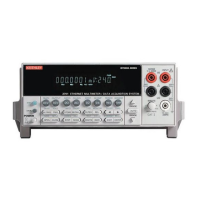2-16 Close/Open Switching Module Channels Model 2701 User’s Manual
Multiple channel operation
The capability to individually control channels provides you with added flexibility in how
you use a switching module. For example, assume you want to route a signal into
channel 1 and out channel 20 of a Model 7700 switching module. You would do this by
closing channels 1, 20, and 23. If you open channels 24 and 25, you will isolate the input
signal from the DMM of Model 2701.
Multiple channel operation allows any channel (or channels) in the test system to be
closed or opened. It allows more than one measurement channel to be closed at the same
time. It also allows individual control of non-measurement channels, such as backplane
isolation channels. Multiple channel operation should only be performed by experienced
test system engineers.
WARNING Careless multiple channel operation could create an electric shock
hazard that could result in severe injury or death. Improper operation
can also cause damage to the switching modules and external circuitry.
Multiple channel operation should be restricted to experienced test
engineers who recognize the dangers associated with multiple channel
closures.
NOTE Multiple channel operation cannot be used to perform thermocouple
temperature measurements using the internal or external reference junction. The
simulated reference junction will instead be used and the integrity of the
temperature reading will be questionable (“ERR” annunciator turns on). See
“Temperature measurements,” page 3-33, for details.
Some other key points for multiple channel operation include the following:
• Closing a channel using multiple channel operation has no affect on other closed
channels. Whatever channels were previously closed, remain closed.
• A channel closed using multiple channel operation is not displayed on the
Model 2701. Also, the CHAN annunciator does not turn on when a channel is
closed.
• Opening a channel using multiple channel operation has no affect on other closed
channels. Only the specified channel opens.
NOTE Use the VIEW option of the CARD menu to display closed channels (see “CARD
menu,” page 2-30).

